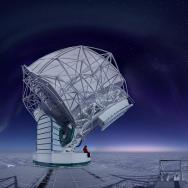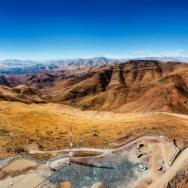On Nov. 4, the National Academy of Sciences released its Astro2020 decadal survey, "Pathways to Discovery in Astronomy and Astrophysics for the 2020s," which outlines a strategy and vision for a decade of transformative science at the frontiers of astronomy and astrophysics. Several University of Chicago projects were endorsed by the report and will lead the field for the next decade and beyond.
"The decadal survey identifies the most compelling scientific goals for our field, and we are excited that the 2020 report affirms the vision and focus of scientists at the University of Chicago," said Angela V. Olinto, dean of the Physical Sciences Division and Albert A. Michelson Distinguished Service Professor in the Department of Astronomy and Astrophysics.
The report identifies three priority areas for investment over the next decade: identifying and characterizing earth-like worlds in other planetary systems; closer study of the most energetic processes in the universe—such as black hole collisions, stellar explosions, and more—to address questions about dark matter, dark energy, and cosmological inflation; and understanding the origins and evolution of galaxies.
Among the projects referenced in the report are several connected to the University of Chicago, including the Giant Magellan Telescope, CMB-S4, LUVOIR, and HabEx.
The University of Chicago is a founding member of the Giant Magellan Telescope, a large, ground-based facility that will be located at Las Campanas in Chile's Atacama Desert. When operational in the late 2020s, it will produce images that are 10 times sharper than those from the Hubble Space Telescope in the infrared region of the spectrum. Astronomers will use these images to study planets around other stars and to look back to the time when the first galaxies formed.
"The Giant Magellan Telescope will immediately bring into focus what is happening in the distant universe so that we can better understand how and when the earliest galaxies formed and evolved," said Wendy Freedman, the John and Marion Sullivan University Professor of Astronomy and Astrophysics and founding leader of the telescope. “It literally will allow us to study the first starlight of the universe.”

The report also states that CMB-S4, a multi-institutional experiment employing 21 telescopes in the South Pole and Chilean Atacama desert for which UChicago plays a lead role, will have a "broad impact on cosmology and astrophysics." CMB-S4 aims to map the cosmic microwave background—the remnant light from the Big Bang—to unprecedented precision to explore the origin and evolution of the universe. CMB-S4 measurements will enable scientists to search for signatures of primordial gravitational waves from the dawn of time, probe the nature of dark matter and energy, and map matter throughout the universe.
"CMB-S4 will help unlock mysteries about the early universe and the physics that govern its evolution," said John Carlstrom, co-spokesperson for the experiment and the Subramanyan Chandrasekhar Distinguished Service Professor in the Departments of Astronomy and Astrophysics and Physics. "We are grateful to the National Academies and the survey committee for their continued support of this research.”
As part of the first priority to identify and characterize Earth-like exoplanets, the report identified the importance of a space-based observatory based on two leading concepts, the Large Ultraviolet Optical Infrared Surveyor (LUVOIR) and the Habitable Exoplanet Imaging Mission (HabEx). UChicago researchers Prof. Jacob Bean and Asst. Prof. Leslie Rogers respectively, have been helping to define the science and technology for these two missions.
“I am thrilled that the decadal report endorsed a large space mission to image Earth-like exoplanets. The search for life beyond Earth is one of the key drivers in our study of planets around other stars,” said Bean. “Prioritizing a LUVOIR/HabEx-type mission will galvanize a new generation of scientists to continue our pursuit of this fundamental question.”
In the past 20 years, the number of known exoplanets has rocketed from just a handful to more than 4,500, and scientists have been working on ways to discover what they’re made of and what their atmospheres look like.
“The decadal survey identifies the most compelling scientific goals for our field.”
“It is inspiring to ponder the exciting science to be done in the coming decades,” said Rogers. “The infrared/optical/ultraviolet flagship telescope will enable astronomers to spectroscopically study the atmospheres of rocky planets orbiting in the habitable zones of sunlike stars. By searching for signs of liquid water oceans on the planets’ surfaces, and signs of biosignature gasses in the planets’ atmospheres, we will discover how common or how special habitable, living planets like the Earth are.”
"The report confirms that the future of research in astronomy and astrophysics at the University of Chicago is bright," said Olinto. "Over the next decade, we will continue to be at the forefront of defining and advancing the field."









